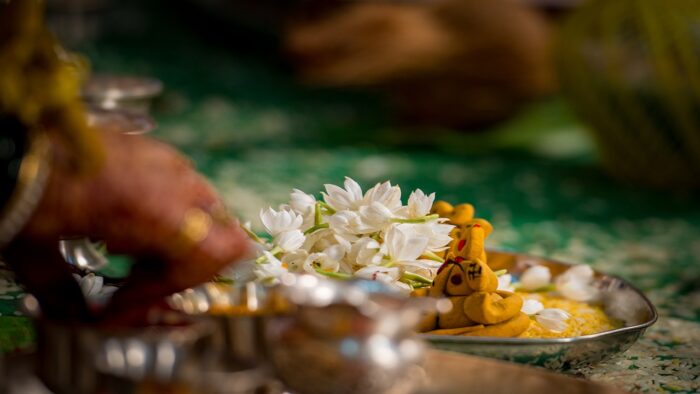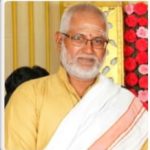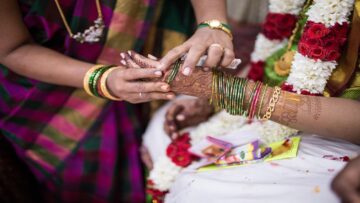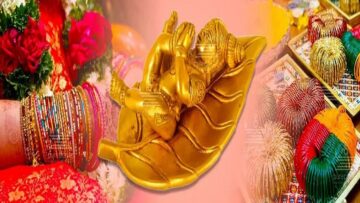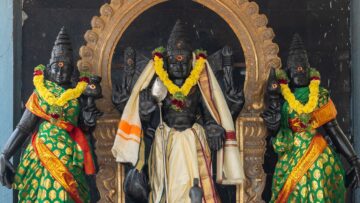Introduction
Sīmantonnayana = Sīmanta + unnayana.
Sīmanta = the middle line on the scalp.
Unnayana = upwardly drawing the line separating or parting of the hair into two halves by thorn of porcupine.
This article will be about the importance of the samskāra called Sīmantonnayana – the parting of the hair and Mauna Vrata (the vow of silence) for the benefit of growing fetus but performed on pregnant woman during her first pregnancy.
Saṃskāras are important to make one healthy, but one important thing imparted by Saṃskāras is the good conduct. (महासत्त्वाश्चिरायुषः – Long life and a Sātvic attitude.)[1] This Saṃskāra is done over the head of the expectant mothers, that we will explore in detail about in this article.
Karṇa’s Great Dilemma
क्रियाकाले त्वनुक्रोशमकृत्वा त्वमिमं मम ।
हीन-संस्कारसमयमद्य मां समचूचुदः ॥7॥
Mahābharata Udyogaparvam – 144 Adhyāya
Often, we have read about Karṇa from Mahābharata. Though he was talented and had some good qualities, he didn’t have an honourable end in the war.
Karṇa had been told that he was the eldest of all Pāṇḍavas by his mother Kuntī Devī, Surya Bhagavān (as a divine voice from the sky – Asiriri)[2], Vasudeva Kṛṣṇa, and Bhīṣmācārya. Though all four of them gave him some valid reasons to switch sides, he was in a “justice delayed is justice denied” mode. (He felt distraught that the important truth arrived too late.)
He couldn’t agree to their pleas and one counter given by him is the lack of Saṃskāras (hīna saṃskāra samayam) at the proper time[3] made him venture along the wrong path.[4]
Saṃskāras makes one closer to divinity, one important thing bestowed by the Saṃskāras is citta śuddhi (purity of mind) which makes one eligible for higher knowledge/ consciousness or tasks.
Bhagavān as our Buddhi
न देवा दण्डमादाय रक्षन्ति पशुपालवत् ।
यं हि रक्षितुमिच्छन्ति सद्बुद्ध्या योजयन्ति तम् ॥
A shepherd uses a staff to control a group of cattle. Bhagavān does not use this method for humans, rather He guides and protects by being the intelligence or wisdom imparted to us.
In Liṅgāṣṭakam, we have this line,
बुद्धि-विवर्धन-कारण-लिङ्गम्।
Buddhi-vivardhana-kāraṇa-liṅgam
बुद्धि = Wisdom or knowledge. विवर्धन = Enhancement.
कारण = Cause/reason. लिङ्गम् = Bhagavān who is in the form of a Linga.
Let the Liṅga be the enhancer of our wisdom or knowledge.
We are also familiar with the below statement.
विनाश-काले विपरीत बुद्धिः।
Vināśa-kāle viparīta Buddhiḥ –
When one is about to undergo calamity, the person’s intellect works against himself/herself.
The śāstras place multiple firewalls through various methods to reduce the intensity of the incoming harm to a minimal level or perhaps even completely nullify it. We need patience and buddhi is needed to utilise what is mentioned in our śāstras.
We know that buddhi is in one’s head. So, let us explore āyurveda’s take on buddhi.
Importance of One’s head (Śiras) and Prāṇa Vāyu
As per āyurveda, one’s head or śiras is called uttama aṅga, the superior part of the whole body. Parallelly as per science, the brain (head) is said to be the command centre of the body performing various tasks.
For buddhi in the head to work properly, prāṇa vāyu is said to be essential and if the Prāṇa vāyu is affected, one person might be dull or lazy, or not enthusiastic.
विशेषात् जीवितं प्राण उदानो बलमुच्यते॥
Aṣṭāṅga Saṅgraha Nidāna Sthāna Adhyāya 16.58
It is said that Prāṇa vāyu is responsible for one to live happily with enthusiasm and udāna vāyu[5] for having physical and mental strength.
Prāṇa vāyu is said to be vital for other bodily functions as well. If we stick to a healthy diet and regime, all the vāyus would be in equilibrium.
So, let us not contemplate this subtle body concept, rather think about a practical example.
There are 10 such spots[6] of prāṇa in the body, two spots among the ten are the chest and anus (the exit way for the body waste). If an asthmatic or COPD person is constipated, the breathing difficulty aggravates. If the prāṇa in the lower regions is affected, then the upper regions’ prāṇas and then udāna vāyu also slowly get affected. (Like a domino effect.)
Even constipation is said to be an impediment to our physical routine as well as for the Kuṇḍalinī śakti and cakra.
Sīmanta Marma
श्रुति-सीमन्त-सिन्दूरी-कृत-पादाब्ज-धूलिका ।
Lalitā Sahasranāma 68
Sīmanta (an area on the scalp) is very important, even Ambikā’s hair is described to have the parting to denote motherhood. Sīmanta is a marma mentioned in our āyurvedic texts.
What is a marma?
मारयति इति मर्म। That which kills is called ‘marma’ (marma points or spots).
Marma spots (important body points dealing with vulnerable blood vessels or bones or nerves where an injury could be fatal) can be considered as a point for attacking, but from a healthcare perspective, marmas are healing points.
In the South, ‘Varma’ is called ‘Marma’. Both are the same concepts with little variations.
Through Sīmanta marma, the cakras are given some energy and as a necessary post-op procedure, the vow of silence is strictly advised for both the husband and wife.
Sīmantonnayana is said to create an exclusive pathway (from a few points through the skull) for Bhagavān to bestow His blessing by entering through the scalp.
Sīmanta marma is classified as a Kālāntara prāṇahara marma, meaning that when Sīmanta marma is injured, it causes death over a period of time. (It is said to kill one’s prāṇa. One may compare that to concussions or haemorrhages.) Since Sīmanta marma is strengthened by powerful Vedic/purāṇic mantras and other rituals, it is made to bestow health (from a āyurvedic healthcare perspective), it becomes Kālāntara prāṇakara marma (the one which bestows prāṇa/life) as mauna is later prescribed as a post-op procedure and to ensure that the cakras work well when during her pregnancy and labour pains.
Kuṇḍalinī Śakti
Kuṇḍalinī Śakti in Yogābhyāsa is an important topic in our scriptures starting from the Vedas, especially the Upaniṣads. Kuṇḍalinī śakti can be explained as a force rising inside the body like a snake. The latent force can be compared to a coiled snake and the active force to an active snake.
The harmony of the cakra from the Mūlādhāra cakra to the Sahasrāra cakra is said to be essential for our good health and do any work with proper satisfaction.
The concept of cakra mentioned in yoga can be found in Patañjali Yoga Sūtra, Śiva Samhitā, Gheraṇḍa Samhitā, Śāṅkara Bhāṣya of Aitareya Upaniṣad, etc. Often the information given in the texts will be limited as a misunderstanding or misuse (by mere reading) of these delicate concepts will have serious repercussions. Hence, a guru is needed to guide the śiṣya till he/she is competent regarding this subject.
The śakti rises from Mūlādhāra cakra upwards gradually. Three things are advised in many Karmas from our Śāstras.
- Gaṇeśa worship is advised as He blesses the worshipper by green lighting the Mūlādhāra cakra. Buddhi and Siddhi, the two wives of Gaṇeśa are said to bestow intelligence and success respectively only their husband is adored.
- Sitting straight is done to ensure that there is a steady upward flow of śakti without interruption.
- Not shaking the head frequently, this can be noted when one is singing or doing a mantra Japa.
In simpler terms, Kuṇḍalinī śakti is given a proper boost, and this Saṃskāra in short is said to activate vital points in the sūkṣma śārīra (subtle body) and the changes are said to be incomprehensible to the average person.
Why is this Saṃskāra done only once?
This is primarily done for the mother as her body keeps changing throughout pregnancy and post parturition (giving birth). As per human physiology, multiple changes occur. Parallelly, her subtle body concerning the cakras or nāḍīs (pathways in the subtle body) also undergoes multiple changes. Any problem with the cakra can also affect the health physically such as post-partum depression, weight gain, anaemia, gestational diabetes, etc.[7]
Sīmantonnayana is only for the first pregnancy, and this will suffice for consecutive pregnancies as well. (The Saṃskāra is done for the mother and all the mother’s children on one occasion.)
The Saṃskāra is for allowing the pregnant lady to get a special blessing from Bhagavān by activating the Sīmanta marmā. (A line is drawn from the anterior end to the posterior end with the items stated to activate a hidden special point in the scalp.)[8]
A straight line must be made over the scalp medially from the anterior end to the posterior end. This step is important and must be done during the suitable muhūrta. The line must not be drawn curved or crooked.
The wife and husband must observe mauna vrata/silence[9] till the nakṣatras are visible in the night. Both must involve themselves in any activity related to Bhagavān or any productive work or recite any Bhagavān nāma mentally. Mauna involves no texting or no writing as well. But words should not be uttered importantly. Please make sufficient arrangements to be prepared.
Why Mauna Vrata?
Mauna is often linked to better memory retention power and mental prowess in śāstras.
Mauna vrata traditionally used to be observed on specific days like Monday (for appeasing Śiva or Candra), on mūla nakṣatra to please Sarasvatī Devī, or on Amāvásyā, etc.
Mauna vrata is said to offer even mokṣa along with extra benefits like great memory power, Vāk Siddhi (one’s speech would be very attractive and whatever uttered would become true), and good mental perseverance.
चान्द्रायणी विष्णुलोकी मौनी स्यान्मुक्तिभाजनम् ।
Agni Purāṇa 198.11
Candrāyaṇī Vrata is a tough vrata that requires lots of fasting (which bestows Viṣṇu loka/mokṣa) and mauna vrata is lauded to be an equally formidable vrata and said to bestow even mokṣa similarly.
Mauna and Yoga
अत्याहारः प्रयासश्च प्रजल्पो नियमाग्रहः।
जन-सङ्गश्च लौल्यं च षड्भिर्योगो विनश्यति॥
Haṭha-Yoga-Pradīpikā 1/15
Talking too much (consider phone/PC texting a minimal form of talking as well) is said to be an obstacle to one’s improvement/routine in life. There are six such impediments mentioned (when these activities become disproportionately excessive) – Excessive eating, physical strain, talking, misunderstanding concepts without a guru’s guidance, frequent participation in social events, and unsteadiness or inconsistency.
(One need not even be practising Yogāsanas, these six act as a negative catalyst for even routine activities. E.g., You may be a skilled chef, but talking too aimlessly or gossiping unnecessarily might make you more tired than usual or you may encounter numerous obstacles or disturbances while you cook.)
If you notice prominent personalities, one thing that you can notice is their mauna, they talk only when necessary. Those gifted persons have some extraordinary superpower like our ancient Rishis, at least an iota of their brilliant prowess.
अन्तर्बहिश्च मननात्कुरुते कर्मनित्यशः।
मौनी शश्वद्वदेत्काले यो वै स मुनिरुच्यते ॥
Brahma-Vaivarta Purāṇam Tṛtīyaṃ Gaṇapati Khaṇḍam – 35/71
The one who does work moving around observing silence and speaks only when necessary is called ‘muni’. In our history, extraordinary siddha puruṣas like Sadāśiva Brahmendra or Ramaṇa Maharṣi have observed strict mauna and have shown mauna’s emphasis.
At what other times can mauna be observed?
As a general rule, it is mentioned in Sīmantonnayana and Vivāha (it will be covered later), but only twice it has been compulsorily mentioned for a stipulated time period in one’s life.
During devāta or pitṛus worship, words must be kept minimal or nil. There are many types of mauna, for an ordinary person, words can be limited to a certain extent and signs can be shown when observing mauna. For a sanyāsī, stricter guidelines have been laid.
प्रचारे मैथुने चैव प्रस्रावे दन्तधावने ॥
स्नानभोजनकाले च षट्सु मौनं समाचरेत् ।
Agni Purāṇa 166.18
One must be silent during the following acts – while passing stools and urine, maithuna (coitus), brushing the teeth, bathing, and eating. This is not a strict rule but avoiding talk or limiting talk at these times is encouraged.
In Rāma mantrava japiso keerthana, Purandara Dāsa[10] has mentioned while bathing or while observing mauna, recite Rāma Rāma mentally. He shows that one can chant Rāma nāma or any Bhagavān nāma mentally to avoid exertion. Mental recitation is said to be superior to loud chanting, bhajans are different. Nāma recital is not like a kabaddi raider telling ‘kabaddi’ (where one can see the lips moving), if you see any māhan, do not be fooled that they are standing or sitting simply, know that they are always reciting some nāma or mantra mentally to emanate positive vibrations to the devotees.
Completion of mauna after Sīmantonnayana
When the Nakṣatras are visible, the couple must worship and touch a Vṛṣabha/bull (one which is not castrated). Then feed the bull and the nearby Gomātās for their blessings. One can even tell their grievance to the bull’s/cow’s ears if they appear happy (due to unfortunate circumstances, some cows/bulls in certain places keep crying for a period of time as they also grieve and experience pain). Usually, one can tell their problems near Gomātā/Vṛṣabha for getting remedy. One must not touch the temple’s Vigraha or mūrtis especially when there is a trend to touch Nandikeśavara’s ears.[11]
Mauna Vrata is completed.
What to do if no bulls are available?
One can go to a temple where Nandikeśavara is available, offer some fruits to Him and then feed cows. If both the bull and cows are unavailable in nearby places, the husband could travel for a bit of distance and feed a bull. Or as a last option, donate for some Gomātā maintenance to one’s capacity. (Feeding and donating are better than merely feeding the bull.) Then complete the mauna vrata.
Vṛṣabha here is a symbolic representation of dharma, good physical strength, and even mental strength. Bull by itself denotes very good physical strength. At the same time, mental strength is also denoted. As per Jyotiṣa, the strength of Candra Bhagavān is at its peak and second-best strength while in Vṛṣabha Rāśi.
Note – Valaikappu or any regional celebration of the pregnant lady can be done on any auspicious day or the same day of Sīmantonnayana Saṃskāra without causing any hindrance to this Saṃskāra (the vow of silence must be observed, and certain edibles/beverages are to be avoided). A baby shower or a grand celebration can be done and it is ideal if the Valaikappu or baby shower happens on another day.
Nothing pleases the Sampradāya gurus more than a sincere adherence to śāstric protocols like these. For guarding precious gemstones or gold, a safe vault is desirable. Likewise, for guarding our precious śāstras, a live demonstration of proper rituals is essential.
Mauna Avatāra of Subrahmaṇya will be covered in the next part.
… To be continued.
[1] Aṣṭāṅga Saṅgraha Śārīra Sthāna-2/42 – Discussed in Puṃsavana part-1.
[2] Mahābharata Udyogaparvam – 144 Adhyāya – More can be read in this portion.
[3] Since he didn’t have the Saṃskāras of a Kṣatriya from Garbhādhāna till Vivāha, he lacked some moral ethics though he did charity and was talented. Though extraordinary individuals had been born bypassing some rituals. The Saṃskāras were done later or were not needed as the appearance of those individuals was limited on Earth (BhuLoka).
[4] He had lied to Paraśurāma, spoken very harsh words against Draupadī, bullied Vikarṇa for adhering to Dharma, getting into a verbal spat with Bhīṣmācārya, and considered himself superior in combat while Bhīṣmācārya and Droṇācārya were being modest about their abilities. Overall, he was destined to act this way and die, but later he re-incarnated as Siruthonda Nayanar.
[5] There are totally ten main Vāyus mentioned and elaborated. Each Vāyu has its own function.
[6] Caraka Saṃhitā Sūtra Sthāna 29 Adhyāya
[7] Saṃskāra is a vital component in managing such problems, but pre-conception, pregnancy, and post-pregnancy care are also mentioned in the texts. (Medical advice is to be sought from a certified physician or obstetrician.) Saṃskāra is to be considered as Bhagavān’s blessing and nutritional/medical regimen is our effort in preventing/managing such conditions.
[8] There are slight variations with the Saṃskāra in this aspect, but all are the opinions of Ṛṣis.
[9] Must not involve in entertainment or pleasure activities while observing silence. Complete cessation of words is required. This vow of silence is said to boost the memory and intelligence of the conceived child.
[10] An āvatara of Nārada.
[11] Only the temple’s Arcakās are eligible to touch them as they undergo special initiation. But only a very few temples allow everyone to touch (or directly offer flowers) a particular Vigraha or mūrti, this rule must not be flouted by us.
Feature Image Credit: istockphoto.com
Disclaimer: The opinions expressed in this article belong to the author. Indic Today is neither responsible nor liable for the accuracy, completeness, suitability, or validity of any information in the article.

